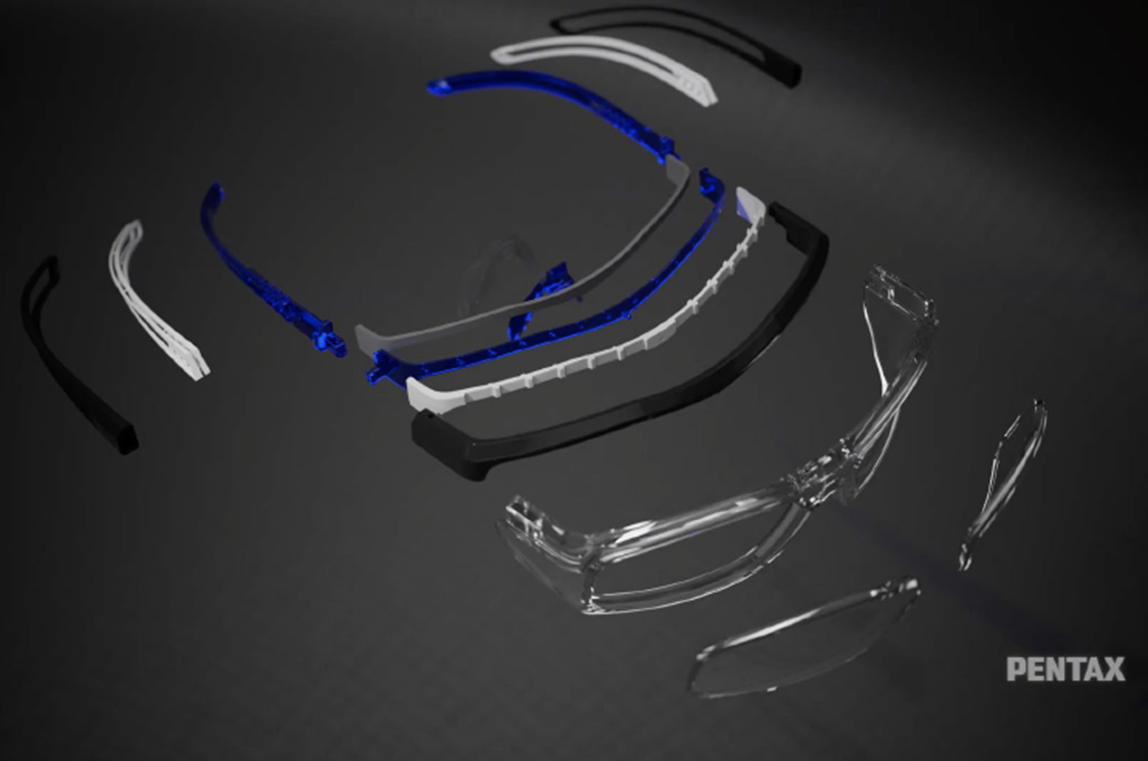14 February 2024
THE ANATOMY OF SAFETY EYEWEAR

When you own a pair of safety eyewear, you should know each part of it and how each component works like anything meant to protect you.
Our eyes are one of the most vulnerable parts of our bodies, so safety eyewear is necessary to keep them protected when working in industrial industries, playing sports, or even working behind desks.
Here are the different types and components that make up the anatomy of safety
eyewear.
THE ANATOMY OF SAFETY EYEWEAR
You might be purchasing safety eyewear or already own a pair for your job, lounging at home looking at screens, or playing a sport. Whatever the reason, there are different types of safety eyewear to consider before purchasing to ensure you are getting the best protection for your situation.
SAFETY GLASSES
Safety glasses can have nonprescription and prescription lenses typically made of polycarbonate or trivex material.
The lenses paired with a durable and robust frame allows this eyewear to have the most options for wearers. Many safety glasses also come with side shields, gaskets, brow bars for protection, and possibly adjustable nose pads & temples for comfort and proper fitting. There are non-conductive styles; styles with removable arms that convert to goggles in seconds; sunglass styles and much more.
OTG SAFETY GLASSES
“Over-the-glasses” (OTG) are a less common option for those who wear prescription eyewear. As the name implies, they’re designed to be worn over other sets of glasses. Employees and employers are less inclined to utilise this because of discomfort and, let’s be honest, style. They’re most often the option for certain hazardous areas in a workplace that are infrequently visited/utilised. In other words, if your workplace requires you to wear safety eyewear all day it’s best to invest in a proper pair of prescription safety eyewear.
SAFETY GOGGLES
Another common type of safety eyewear worn by many industries is safety goggles. Safety goggles are typically worn when a work environment requires protection against fine dust, hazardous fumes, or liquids.
They can be made in nonprescription and with prescription lens inserts. There are three different types of goggles: non-vented, direct vented (small holes at top and bottom of frames) or indirect vented (angled holes that are rear facing and often adjustable).
WHAT SAFETY EYEWEAR FEATURES TO CONSIDER
Now that you know the most common types of safety eyewear, let’s get into the features of safety-specific eyewear as PPE.
TRIVEX & POLYCARBONATE LENSES
When it comes to prescription safety eyewear there are many options to consider but also standards to be mindful of. Impact resistance is the most critical difference when selecting prescription safety eyewear. All safety eyewear lenses must comply with the AS/NZS 1337.6 standards for impact resistance.
Both Trivex and Polycarbonate lens materials have been recognised as medium impact through independent testing according to requirements set out through the AS/NZS 1337.6 standards. Both are a superior quality material that does not shatter or break if dropped or hit at high speeds. They can also withstand extremely hot temperatures and block 100% of UV rays.
At All Australian Safety we recommend and use the HOYA proprietary brand of Trivex material called Phoenix. They share all the benefits of polycarbonate including being lightweight, providing optical clarity, offering 100% UV protection, and impact resistance. PLUS, they’re far more chemical resistant than polycarbonate and, due to their manufacturing process, they are better suited for high wrap frames like sunglasses.
SIDE SHIELDS
Side shields are added to eyewear to cover any large gaps to the sides of your eyes to prevent particles, dust, or liquids from entering your eyes from the sides. These are more common with styles that are more like standard everyday frames. Many side shields are made of polycarbonate material which is, again, medium impact rated. On the other hand, wraparound styles with a high curve tend to be designed with temples wide enough to cover the sides of your eyes. These styles are more similar to sporty sunglasses but have been tested according to standards set out in AS/NZS 1337.6.
GASKETS OR POSITIVE SEALS
Typically made from a foam or thermoplastic materials, gaskets are put on safety eyewear to create a firm seal on the wearer’s face. This seal keeps dust, wind, and other irritating particles out of the eyes.
NOSE OR TEMPLE PADS
Nose and temple pads are made of similar materials and also enhance comfort and adjust to an individual’s features while playing sports or on the job, specifically in construction.
ASK AN ALL AUSTRALIAN SAFETY CONSULTANT
If you are looking to purchase or have purchased a pair of safety eyewear but aren’t sure what all the features help protect, reach out to one of our consultants at All Australian Safety! Our team is here to answer any of your questions about every piece and part of your prescription safety eyewear. Contact us today at info@allaustraliansafety.com.au.


